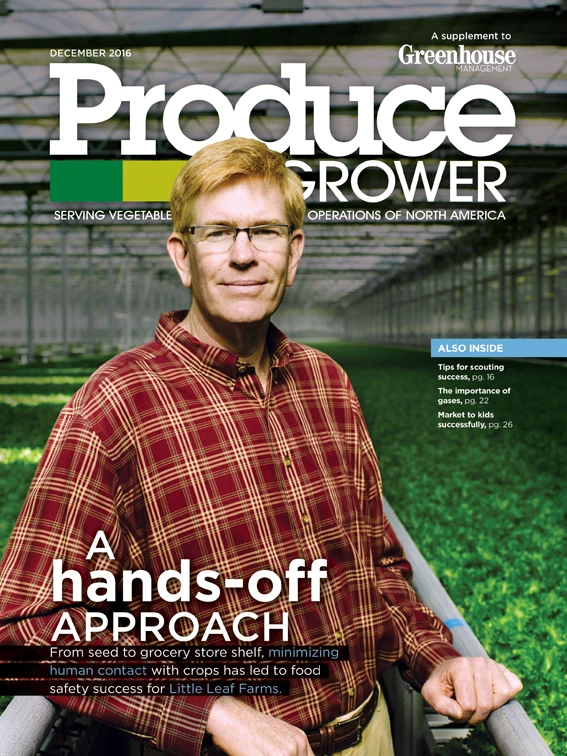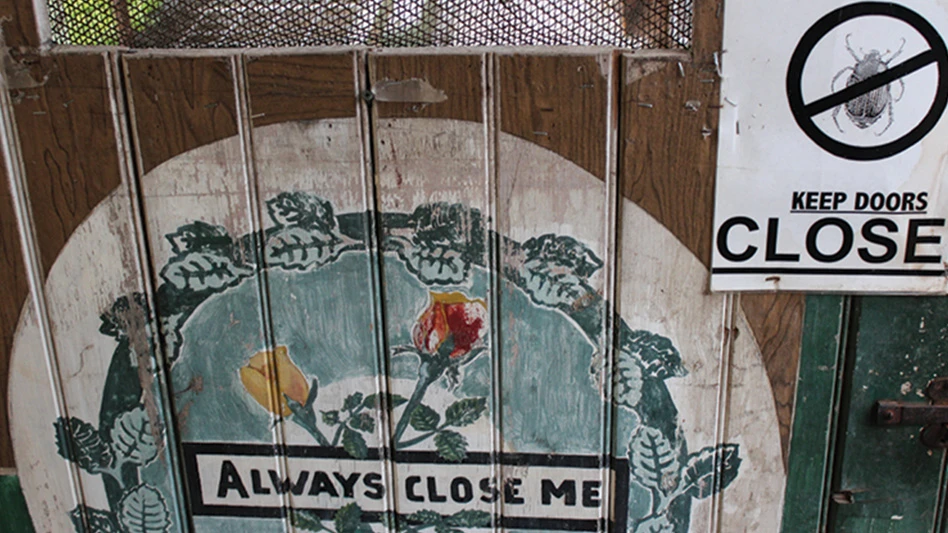
If you’ve eaten a salad recently, your greens more than likely grew in a field in California or possibly Arizona, the two states with the highest acreage of lettuce production. According to the USDA Vegetables 2015 Summary published in February 2016, Californian field growers planted 87,000 acres of head lettuce, 39,500 acres of leaf lettuce and 64,000 of romaine lettuce in 2015 — that’s 73 percent, 81 percent and 76 percent, respectively, of the total acreage planted in the U.S.
However, for salad lovers living outside of California and Arizona, fresh, locally grown greens typically aren’t available year-round; they must be shipped hundreds, sometimes thousands of miles. Besides the environmental and food safety concerns of moving a product across long distances, they simply aren’t as fresh by the time they make it to their destination.
If you’re in the greater Boston area, though, you’re in luck. This past summer, a new high-tech baby greens and baby lettuces grower appeared on the scene. Enter Little Leaf Farms, a hydroponic greenhouse operation located about 35 miles outside of Boston in rural Devens, Mass.

A quest for fresh
Little Leaf Farms was founded by CEO Paul Sellew, a New England entrepreneur who grew up in the horticulture industry. Sellew studied horticulture at Cornell University and went on to found several related companies, including Earth Grow, a composting and growing mix business, and Backyard Farms, a hydroponic tomato grower in Maine.
“Based on the success of Backyard Farms, we realized that there really is a good market for year-round, high-quality, great-tasting produce,” Sellew says. “My interest is in greenhouses [and] controlled environments so you can supply the market year-round. I was looking for other suitable produce items, and of course leafy greens is a big category.” In addition, Sellew notes that up to 90 percent of the fresh produce consumed in Massachusetts is trucked in from out-of-state farms. The concept for a year-round, hydroponic lettuce operation named Little Leaf Farms was born.
The catchy name is a reference to the baby greens that the company grows. “We wanted something that would accurately describe what we’re doing,” Sellew says. “We’re harvesting baby greens [and] baby lettuces. So they’re not going to be big leaves, they’re going to be little leaves. We followed that thinking and named it Little Leaf Farms.”
In September 2015, the Little Leaf Farms team broke ground on a greenhouse that was completed in spring of 2016. Their baby greens were introduced to local retail grocers and leading food service distributors this past summer.
Filling a niche
Over the past 25 years, U.S. per capita consumption of head lettuce has decreased from 27.7 to 13.5 pounds at the same time as leaf and romaine lettuce consumption has increased from 3.3 to 11 pounds (USDA Vegetable and Pulses Yearbook, 2016). Consumers are ditching iceberg lettuce in favor of more flavorful greens, a trend that Little Leaf is banking on.
When deciding which varieties to produce, Sellew and his team looked to grocery stores to see what was most popular in the produce department, which turned out to be salad mixes. “We grow a number of different varieties, and then have the ability, with our system, to blend them into a salad mixes,” he says.
Currently, the operation is producing green leaf, red leaf, frisée, chard and arugula crops. “We love the product that we’re growing,” Sellew says. “It tastes and eats really, really well and we’re proud of the quality of it. We’ve gotten great support from the local market.”
However, Sellew is open to adding to the line-up in the future. Trials are underway to determine what will suit their future needs and market demand.

Automating food safety
The most unique aspect of Little Leaf Farms is its high-tech, “hands-off” hydroponic growing system that enables the operation to maintain high food safety standards and reduce labor needs. Little Leaf uses a type of nutrient film-technique (NFT) system that was developed in Finland and is used in several facilities throughout Europe. “It’s called a mobile tray system,” Sellew says. “The idea is that as the plants grow, they move from one end of the greenhouse to the other and the trays separate from each other as the plants grow, so that there’s never any shading.” And this process is all automated, which is how the baby greens are grown in a “hands-off” environment.
The seeds are sown into a rockwool growing medium in the mobile trays and are then moved to and through the greenhouse, where they’ll grow to the desired size before the system moves them to be cut and packed by machine — all without being handled by humans. By the time they leave the building, they’re sealed and ready for consumers.
The automated system helps Little Leaf to be “Clean From the Start,” a phrase that they’ve trademarked. This refers to the fact that because the plants are not contaminated with soil, diseases, chemicals or human elements, they’re clean to begin with, and don’t need to be washed in a chlorinated solution or sprayed with chemicals like field-grown greens.
Little Leaf Farms does not use chemical pesticides and is a strong believer in biological controls. “We have a very well-managed, sophisticated biological control program in the greenhouse,” Sellew says. “We’re comfortable with that being the best way to manage disease and insect pressure.”
Head grower Peter Slaman is the fourth-generation organic lettuce grower from Holland that manages the biological control program in the greenhouse.
The operation is also certified through a Safe Quality Foods (SQF) program, a program with internationally recognized food safety standards. Being certified through SQF also means being Good Agricultural Practices (GAP)-compliant, Sellew says. Their controlled environment production system and processes gives them a considerable advantage over field-grown greens. “It’s a controlled environment, so basically the plants grow free from anything that could potentially bring a disease in,” Sellew says. “The certification just documents what we’re doing, but really it’s inherent in the system that we built and are operating. That’s ultimately how the product stays clean.”
And Little Leaf’s efficient system and proximity to its market means a quick turnaround between the time the greens are harvested and when they hit the grocery store shelves. “I think the key difference is that we have a product that we can cut and harvest and deliver in 24 hours, so the consumer is going to get a better-tasting product,” Sellew says.
Eco-friendly practices
Conserving resources and being environmentally friendly is an important part of Little Leaf Farms’ philosophy. Their greens are only shipped to areas within a day’s drive of the greenhouse to reduce the expense and impact of food miles. While their NFT hydroponic growing system uses up to 90 percent less water than field-grown lettuce, they’ve taken further steps to be water-friendly by installing a rainwater basin that captures the runoff from the greenhouse roof. The water then passes through an ultraviolet disinfection process and is stored in a covered tank until it’s needed for the plants. “Even though we’ve been in a drought condition here in Massachusetts this summer, there’s been plenty of natural rainwater to provide to our plants,” Sellew says.
One of the benefits of the greenhouse’s location in Devens is that much of the electricity that they use comes from a provider that uses solar fields as part of their electricity grids, Sellew says. Little Leaf Farms can (and does) include this fact as part of their sustainability message.
To conserve energy, Little Leaf uses a high-efficiency boiler to heat the greenhouses. “And we also have a condenser on our boiler so that when we’re running our boiler in the cooler times of the year, we capture the CO2 that ordinarily would be discharged into the atmosphere,” he says. And enhanced CO2 levels also mean that plants grow faster, which is a benefit.
Because the operation grows lettuce year-round, supplemental lighting is needed during seasons with shorter days. Little Leaf decided to use LED lighting for a few reasons, including seeing that it was already being used with great success at other lettuce and leafy greens growers. In addition, Sellew liked that with LEDs, “You don’t end up having heat put into your greenhouse,” like you would with other lighting types. The potential to adjust the light spectra to best suit their needs and create a tastier product was also part of the appeal. Lastly, and most relevant to the company’s eco-friendliness, they would be using significantly less electricity than they would with high-pressure sodium and other types of lighting.

Team importance
While the labor needs of Little Leaf Farms’ hydroponic system aren’t as demanding as other systems, it’s still vital to hire dedicated employees who share and support the company’s goals. Currently, Little Leaf employs 10 people, from the technicians who run the machine area, to the laborers who load pallets and load them into the trucks, to the head and assistant growers, to those who handle sales and financial aspects.
Sellew drew on his considerable experience and professional connections in the industry to construct a solid team, and therefore avoid some of the labor woes of other greenhouse operators who struggle to find high-quality workers. “You need to have dedicated people that are passionate about the opportunity and ideally you’ve known from your past experiences so you know their character, you know what they’re all about,” Sellew says. “And [then you can] build a team that can trust each other and work toward building a successful company.” For example, Sellew brought on Tim Cunniff, with whom he had worked closely as part of the Backyard Farms team, to be Little Leaf Farms’ executive vice president of sales and marketing.
When it came to the more specialized grower positions, Sellew looked both near and far. He brought on Tanya Merrill, a Cornell University graduate specializing in horticulture, to fill the role of assistant grower, and Dutch grower Pieter Slaman to head up the growing operations.
“We have a great, great team as far as somebody who is highly educated here in the States and has the book knowledge [Merrill], and Pieter, who is a very experienced, hands-off operator,” Sellew says. “The idea then is [that] both people learn from each other. Ultimately, if you’re going to be successful, you really have to grow your growers because they’re so important to the success of your operation.”
Public perception
The fact that the greens are grown in a clean and sustainable operation close to their market, rather than being shipped in from a field grower on the West Coast, creates added value at the consumer level. Communicating that value is important in order to be able to command a good price.
That communication begins with the tagline: Born Local, Raised Right. “I think that captures some of our key value propositions to the consumer,” Sellew says. Little Leaf provides the grocery store with point-of-purchase display signs that tout this locally and sustainably grown message, and it appears below the brand’s logo. One of the display signs shows how many miles away it was grown, which is different depending on the grocery store’s individual location. “Basically [we’re] communicating that it’s something that was grown maybe 20 miles, 30 miles from that store,” Sellew says. “It’s a completely different value proposition as compared to the West Coast product that is grown and shipped across the country.”
Little Leaf Farms’ salad mix bag is brightly colored and has an actual checklist of reasons you should buy it right on the front in addition to the tagline (see below). It’s “clean and ready to eat,” “sustainably grown” and “pesticide-free,” according to the bag. The side of the bag contains an explanation of their “Clean From the Start” philosophy, why their lettuce is better tasting and a statement about their seeds being non-GMO. No opportunity to communicate with consumers is wasted on the packaging and signage — not even on the cardboard boxes used to transport the greens to foodservice customers, which have less colorful, but still very consistent branding and messaging.
Looking forward
While Little Leaf Farms has only been distributing its product for a short time, their success has the company thinking toward the future. “We’re going to reinvest back into the business and that [will] help to grow it,” Sellew says. The goal is to eventually reach 10 acres of greenhouse growing space “over a number of years.”
For growers who are contemplating moving into hydroponic lettuce growing using a high-tech system such as the one Little Leaf has, Sellew has a few words of advice. “[First of all], you need to have the financial wherewithal to participate [in the market] — and it’s a competitive marketplace. The California and [other] West Coast producers do a great job,” he says. “The market is being served and you have to have something that’s going to be better. You’re going to have to gain the trust and traction with the end consumers. It’s not an easy undertaking.” As for Little Leaf Farms, he says, “We’re in it for the long-term.”

Explore the December 2016 Issue
Check out more from this issue and find your next story to read.
Latest from Produce Grower
- AmericanHort accepting applications for HortScholars program at Cultivate'25
- BioWorks hires Curt Granger as business development manager for specialty agriculture
- Bug budget boom
- Don’t overlook the label
- Hurricane Helene: Florida agricultural production losses top $40M, UF economists estimate
- Little Leaf Farms introduces Sweet & Crispy Blend
- IFPA’s Foundation for Fresh Produce to launch Sustainable Packaging Innovation Lab with USDA grant
- No shelter!





